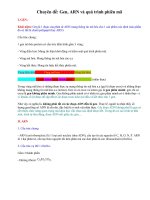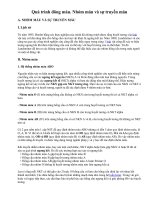RNA và quá trình phiên mã
Bạn đang xem bản rút gọn của tài liệu. Xem và tải ngay bản đầy đủ của tài liệu tại đây (545.75 KB, 52 trang )
Basics of RNA structure and
modeling
Rui Alves
RNA functions
Storage/transfer of genetic information
•
Genomes
•
many viruses have RNA genomes
single-stranded (ssRNA)
e.g., retroviruses (HIV)
double-stranded (dsRNA)
•
Transfer of genetic information
•
mRNA = "coding RNA" - encodes proteins
RNA functions
Structural
•
e.g., rRNA, which is a major structural component of
ribosomes
BUT - its role is not just structural, also:
Catalytic
RNA in the ribosome has peptidyltransferase activity
•
Enzymatic activity responsible for peptide bond
formation between amino acids in growing peptide
chain
•
Also, many small RNAs are enzymes
"ribozymes"
RNA functions
Regulatory
Recently discovered important new roles for RNAs
In normal cells:
•
in "defense" - esp. in plants
•
in normal development
e.g., siRNAs, miRNA
As tools:
•
for gene therapy or to modify gene expression
•
RNAi
•
RNA aptamers
RNA types & functions
Types of RNAs Primary Function(s)
mRNA - messenger translation (protein synthesis)
regulatory
rRNA - ribosomal translation (protein synthesis) <catalytic>
t-RNA - transfer translation (protein synthesis)
hnRNA - heterogeneous nuclear precursors & intermediates of mature mRNAs
& other RNAs
scRNA - small cytoplasmic signal recognition particle (SRP)
tRNA processing <catalytic>
snRNA - small nuclear
snoRNA - small nucleolar
mRNA processing, poly A addition <catalytic>
rRNA processing/maturation/methylation
regulatory RNAs (siRNA, miRNA,
etc.)
regulation of transcription and translation,
other??
L Samaraweera 2005
miRNA Challenges for
Computational Biology
• Find the genes encoding microRNAs
• Predict their regulatory targets
• Integrate miRNAs into gene regulatory pathways & networks
•
Predict RNA structure
Computational Prediction of MicroRNA Genes & Targets
Need to modify traditional paradigm of "transcriptional
control" primarily by protein-DNA interactions to include
miRNA regulatory mechanisms!
•
RNA primary structure
•
RNA secondary structure & prediction
•
RNA tertiary structure & prediction
Outline
Hierarchical organization
of RNA molecules
Primary structure:
•
5’ to 3’ list of covalently linked nucleotides,
named by the attached base
•
Commonly represented by a string S over
the alphabet Σ={A,C,G,U}
•
RNA primary structure
•
RNA secondary structure & prediction
•
RNA tertiary structure & prediction
Outline
Hierarchical organization
of RNA molecules
Primary structure:
Secondary Structure
5’ to 3’ list of covalently linked nucleotides, named by the attached base
Commonly represented by a string S over the alphabet Σ={A,C,G,U}
List of base pairs, denoted by i•j for a pairing between the i-th and j-th
Nucleotides, r
i
and r
j
, where i<j by convention.
Helices are inferred when two or more base pairs occur adjacent to one another
RNA synthesis and fold
Adenine
(A)
Cytosine
(C)
Guanine
(G)
Uracyl
(U)
Watson-Crick
Base Pairing
Wobble
Base Pairing
•
RNA immediately starts to fold when it is
synthesized
RNA secondary structures
Single stranded bases within a stem are called a bulge of bulge loop if
the single stranded bases are on only one side of the stem.
If single stranded bases interrupt both sides of a stem, they are called an
internal (interior) loop.
RNA secondary structure representation
(((.((( ))).(((((( )))).)) )))
AGCUACGGAGCGAUCUCCGAGCUUUCGAGAAAGCCUCUAUUAGC
Circular representation of RNA
Why predicting RNA secondary
structures ?
Virus RNA
RNAse
Existing computational methods
for RNA structure prediction
•
Comparative methods using sequence
homology
–
By examining a set of homologous sequence along with their
covarying position, we can predict interactions between non
adjacent positions in the sequence, such as base pairs, triples,
etc.
Existing computational methods
for RNA structure prediction
•
Minimum energy predictive methods
–
Try to compute the RNA structure solely based on its
nucleotide contents by minimizing the free energy of the
predicted structure.
Existing computational methods
for RNA structure prediction
•
Structural Inference Methods
–
Given a sequence with a known structure, we infer the
structure of another sequence known to be similar to the first
one by maximizing some similarity function
RNA structure prediction
Two primary methods for ab initio RNA secondary
structure prediction:
-
Co-variation analysis (comparative sequence analysis)
. Takes into account conserved patterns of basepairs during
evolution (more than 2 sequences)
-
Minimum free-energy method
. Determine structure of complementary regions that are
energetically stable
Quantitative Measure of Co-variation
( )
( )
( ) ( )
{ }
∑
∈
=
UGCANN
ji
ji
ji
NfNf
NNf
NNfjiH
,,,,
21
21,
221,
21
,
log,),(
Mutual Information Content:
f
ij
(N
1
,N
2
) : joint frequency of the 2 nucleotides, N
1
from the i-th column,
and N
2
from the j-th column
f
i
(N) : frequency in the i-th column of the nucleic acid N
•
Maximize some function of covariation of
nucleotides in a multiple alignment of RNAs
•
Why?
•
If two nucleotides change together from AU to
GC they are likely to be a pair and the pair
should be important for the RNA function
Co-variation
G C U A
i 5/7 1/7 0 1/7
j 1/7 5/7 1/7 0
G C U A
G 0 0.6 -0.4 0
C 0.6 0 0 0
U -0.4 0 0 0.4
A 0 0 0.4 0
Computing RNA secondary structure:
Minimum free-energy method
•
Working hypothesis:
The native secondary structure of a RNA molecule
is the one with the minimum free energy
•
Restrictions:
–
No knots
–
No close base pairs
–
Base pairs: A-U, C-G and G-U
Computing RNA secondary structure:
Minimum free-energy method
•
Tinoco-Uhlenbeck postulate:
–
Assumption: the free energy of each base pair
is independent of all the other pairs and the
loop structures
–
Consequence: the total free energy of an RNA
is the sum of all of the base pair free energies
Independent Base Pairs Approach
•
Use solution for smaller strings to find
solutions for larger strings
•
This is precisely the basic principle behind
dynamic programming algorithms!
RNA folding: Dynamic Programming
There are only four possible ways that a secondary structure of
nested base pair can be constructed on a RNA strand from position i to j:
1. i is unpaired, added on to
a structure for i+1…j
S(i,j) = S(i+1,j)
2. j is unpaired, added on to
a structure for i…j-1
S(i,j) = S(i,j-1)









